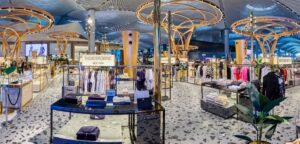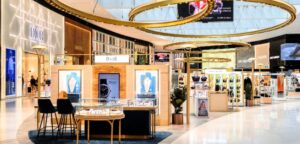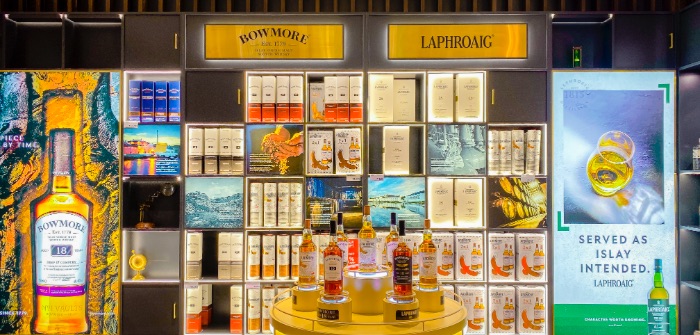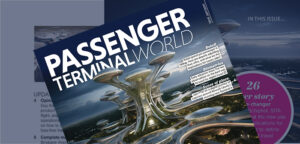Many major airports regard high-end shopping as a mainstay of their proposition – but as Kevin Rozario discovered in an exclusive feature first published in the January 2024 issue of Passenger Terminal World, after Covid, some fine-tuning might be necessary.
One constant gripe of passengers at airports – particularly hubs – is that they are expensive retail locations, full of unaffordable luxury boutiques. Labels like Burberry, Cartier, Dior and Louis Vuitton loom large in gateways like London Heathrow, Istanbul and Sydney – and there are some good reasons for that.
High margins and the image factor are two important elements. However, before the pandemic, airports and their retail partners were so eager to cater to high-spending travelers like the Chinese and Russians that they took their eye off their volume, mostly domestic, customers.
When Covid-19 halted all but essential travel – and the Chinese were penned within their borders – airports around the world were forced to change tack and focus on their regular, more price-sensitive travelers. At the time, special offers like two-for-ones and straight discounts became commonplace as airports tried to appeal to the few passengers that were present.
Since January 2023, the Chinese have been allowed to travel internationally again, though their disproportionate impact on airport retail revenue is yet to return because their volumes still haven’t. For example, an analysis of the China-US market by Dion Zumbrink, an aviation business advisor and traffic forecaster, shows that although traffic from China has picked up this year, it is still only around 6% of 2019 levels. “It will probably only top out at just over 10% of its pre-pandemic level by the end of the year [2023],” he says.
That’s bad news for luxury retail at US West Coast gateways like Los Angeles (LAX) and San Francisco (SFO). LAX’s Tom Bradley International Terminal is geared to a high-end offer led by LVMH-owned DFS Group. The luxury travel retailer operates the duty-free shops and high-end boutiques like Burberry, Gucci and Hermès at the terminal but has not yet reopened its fashion and watches multibrand store – a telling sign.
LAX’s operator, LAWA, generated US$56m from its duty-free business in FY2020 (ending June 2020). In its last available statement for FY2022, this had recovered to US$22m, which means there is still a very long way to go for DFS to get back on track.
In its third-quarter results, luxury conglomerate LVMH said that DFS was “benefiting from recovery in international travel”. However, the travel retailer’s focus has shifted, for now, to downtown duty-free locations in Greater China such as Macau and Hong Kong, where the Chinese are returning, and to the reopening of its Waikiki Galleria in Hawaii.
In the first half of 2023, London Heathrow Airport’s owner revealed strongly rebounding traffic at 37.1 million, just 4% off 2019 over the same period. But while two of its three core revenue streams – aeronautical and ‘other’ – moved ahead of Q1/Q2 2019, retail did not (achieving US$390.5m versus US$411m). Heathrow – where Avolta (formerly Dufry) is the duty-free partner – said its sales were hampered by the UK government’s decision to remove VAT-free shopping for tourists. This, the company said, had pushed retail revenue per passenger down by 8.3% to US$10.53 versus US$11.49 in 2022.
There is evidence in an August 2023 report from the Centre for Economics and Business Research (CEBR) that the removal of tax-free shopping for tourists to the UK is costing the economy more than US$12bn in lost revenue from segments such as luxury, dining and accommodation. Travelers looking for savings on high-end goods – typically rich frequent travelers – are shifting their spending to other cities in Europe such as Paris and Milan.
This may be one reason why first-half retail results at Groupe ADP, the operator of Paris Charles de Gaulle Airport and Paris Orly, are much better than Heathrow’s. Although the Paris traffic rebound has not been as good (still 10% behind 2019), the airports’ new Extime retail proposition, where Lagardère Travel Retail is the core partner, saw sales per passenger hit US$31.36 in the first nine months of 2023, well above the US$23.84 seen in Q1/Q2 2019.

Spend per passenger collapses
Management consultancy Kearney revealed a new report commissioned by the Tax Free World Association (TFWA) at the latter’s global exhibition and conference in early October 2023. The title, Travel Retail Faces Its Moment of Truth, was ominous – and for good reason.
Kearney analysis showed that, although traffic is bouncing back in all global regions, average travel retail spend per passenger collapsed by 29% in 2022 to just US$17. This is lower than the average seen in the period 2009-2018, and also below 2019.
Charles-Etienne Bost, a Kearney partner and head of the consumer goods, retail and luxury business for Europe, said that while the pandemic was a significant shock to the travel retail industry, the underlying factors necessitating a rewiring of global aviation and travel retail “were lurking even before the first headlines from China”. He added, “The important thing will be to recognize how passenger behaviors and trends around travel have changed.”
So will luxury and other brands need to be on alert? Given that one key message from the report is that there is now a disconnect on pricing – with 64% of passengers saying they are dissatisfied with travel retailer pricing or the choice of goods on offer – a change may be in order.
But views in the industry are mixed, as PTW found out during the TFWA show in Cannes. Alessandro Eucaliptus, head of travel retail at LVMH eyewear arm Thélios, said at the show, “We are trying to further elevate the sunglasses category, which is one of the fastest growing in travel retail. It’s a question of catching the right consumers. We believe travelers in Southeast Asia will increase their spending on luxury products.”
At Rituals, where company sales hit US$1.9bn in 2023, founder and CEO Raymond Cloosterman said he had no plans to change the beauty brand’s ‘accessible luxury’ despite being in a crowded market. “We are well placed with 700 shop-in-shops in travel retail and 20 new standalone stores in 2023,” he noted.
Meanwhile, at the other end of the market, Japanese skincare brand Sensai, where prices in travel retail generally start at US$106, is seeing good growth largely because consumers want better quality when it comes to skin treatments, according to the company’s director of brand operations, Junichi Uko.
Premiumization and added value
At beauty house L’Occitane, which has a series of brands in travel retail, from the high-end Elemis to the fast-growing Sol de Janeiro, there is a rethink going on. Laurent Marteau, L’Occitane’s group managing director, told PTW, “We’re seeing the premiumization trend continuing, mostly under the influence of fashion brands, which are taking more space in airports
“But we also see younger customers like Gen Z trying new brands such as Grown Alchemist. Premiumization is happening, but it is not answering all passengers’ needs. The Chinese are still not back, so if you create a different offer, you can find a new clientele.” The group MD’s point ties in with the findings of the Kearney report when it comes to broadening the product offer to match the needs of evolving travelers and offer a greater assortment.
The biggest beauty player in travel retail is L’Oréal, with a slew of luxury brands like Lancôme, Prada and YSL. The company’s travel retail boss, Vincent Boinay – soon to depart for a key Asian role based in China – was frank in his assessment: “From all the travel retailers around the world we hear that traffic is increasing extremely fast but the business is not keeping pace. Collectively, this means we have a challenge starting with penetration.”
This is why L’Oréal has invested heavily in preflight marketing and in-store digital tools to bring passengers into stores and keep them entertained while they are there. “Then we need to ensure in-store conversion by using a differentiated offer in travel retail from elsewhere,” said Boinay.
This is also a strategy at non-luxury suppliers. Premiumization has always been a feature of confectioner Nestlé’s travel retail development; for example, by differentiating its products such as KitKat from the local market. It uses special packaging and finishes, or personalized sleeves, thus playing the added-value card, which is important as a high proportion of its products are bought as gifts.
“The strategic imperative for us is to make products giftable and add the value on top so that the shopper is willing to pay more,” said travel retail marketing manager Aura Sanchez. The company’s latest launch is a new travelexclusive chocolate brand called Nestlé Sustainably Sourced Cocoa. Aimed at environmentally conscious consumers, it has “been embraced” by key retailers in airports according to travel retail general manager Stewart Dryburgh.
Italian luggage and bag brand Bric’s is moving cautiously. “For us, travel retail is restarting now,” commented travel retail manager Michele Maccapani. “We opened a standalone store in April last year at Frankfurt Airport and will reopen one at Rome Fiumicino in March 2024. It was originally launched six months before the pandemic began.” The stores, where a cabin bag might set you back US$478, also feature Porsche Design luggage products, which are at a higher price position and more male oriented so the two brands are complementary, catering to a wide range of shoppers.
At high-end London-based jewelry brand Tateossian, where duty-free collections generally sit in the US$122- 213 range, CEO Robert Tateossian told PTW, “At the moment, a lot of the travel retail buyers are coming to us rather than the other way around. It feels like we’re at the beginning of that cycle of growth again.” The brand is in airports in Abu Dhabi and Jeddah as well as with several airlines, and is excited about future prospects.
Wine and spirits push upward
Over the years, the wine and spirits category has been one of the biggest drivers of premiumization in airport retail, and a recent spate of expensive promotions shows that the drive to sell high-end products is very much alive.
In tequila, an activation for Maestro Dobel from Proximo Spirits ran through the summer at New York’s JFK Airport. Meanwhile, Diageo’s travel retail division launched Tequila Don Julio 1942 into European travel retail at London Heathrow T5 in August. Complete with a DJ and dedicated tasting bar, the US$216 product (70cl) was targeting the well-heeled jet-set clubbing crowd heading to places like Ibiza.
Diageo, the owner of Johnnie Walker, has done its research by analyzing category dynamics and the motivations of travel retail consumers. It has found that 15% of passengers go to the alcoholic beverage area, where they spend US$85 on average, while 40% go into wider duty-free. Andrew Cowan, managing director of Diageo Global Travel, said, “If you turn that 15% into 20%, the 40% into 45% and the US$85 into US$95, and then iterate that between today and 2030, you double-size the category.”
Pernod Ricard – where brands include Absolut vodka, Beefeater gin, Chivas Regal whisky and Havana Club rum – has also pursued a strong luxury agenda. The most striking was the August to November 2023 showcasing of five rare limited editions of Royal Salute whisky at a pop-up at Sydney Airport, with a combined value of US$160,000.
The Chivas Brothers CEO, Jean-Etienne Gourgues, said, “We have seen a lot of traction for our high-end products in the Chivas and Royal Salute ranges as we’ve come out of Covid. But hyper-dynamic growth cannot happen over a long period when you are talking about products that may have been aged for 21 years, because of the inventory dynamics.”
He added, “The conversion rate in travel retail is something like 5%, which is very low, but some airports, for example Dubai, have made huge changes to improve the retail experience, as have Taipei in Taiwan and Singapore Changi.”
Having developed a 200-strong single-malt whisky showcase earlier this year, Mumbai Duty Free is taking that up to 300 variants, driven by consumer demand for expensive and unusual varieties of Scotch. Among the offerings is a Bowmore 1965 52-year-old bottle retailing for US$50,000.
A year ago, Qatar’s Hamad International Airport unveiled a garden-like extension featuring some of the world’s most desirable labels. These include Louis Vuitton and Fendi, which has its own café, and Boss, Bulgari, Burberry, Dior, Gucci, Moncler, Montblanc, Omega, Polo Ralph Lauren, Tiffany and Zegna. So it appears that luxury in travel retail remains resilient, despite the missing Chinese – who will eventually return. Although Kearney has highlighted some important areas of concern, notably price competitiveness, the trend toward more luxury at airports is unstoppable.

Saudi airports – excelling the shopping and dining experience
Airports in the Kingdom of Saudi Arabia – the Middle East’s largest aviation market – are going through a massive commercial transformation in line with the goals of the Saudi Aviation Strategy. Don’t miss Matarat Holding’s Marcus Spahn’s presentation showcasing how the Kingdom’s airports are improving their shopping and dining while leveraging revenue opportunities with new large-scale commercial developments, innovative concepts, digitalization, sense of place and customer-centricity. Previously Munich Airport’s CCO at Sofia Airport and at Cairo Airport, Marcus is now responsible for non-aeronautical revenue at Matarat’s 27 Saudi international and domestic airports, serving 100 million passengers.
From haute parfumerie to fine wine
Travel retailers are developing their own high-end concepts, underlining their faith in the future of luxury. This year, Travel Retail Norway opened a fine wine space at Oslo Airport and Avolta launched its first haute parfumerie at Zurich Airport.
The temperature-controlled fine wine room is in Oslo’s revamped arrivals area, and offers specially selected products for collectors and connoisseurs. A spokesperson said, “This is where you’ll typically find the business traveler who we try to cater to with something more unique.” As well as limited editions, with prices ranging from US$400 to US$925, there was a limited supply of Dom Pérignon 2000 P2 Rose Champagne at US$1,635 a bottle at the start of the summer.
Meanwhile, Avolta’s 80m2 haute parfumerie at Zurich Airport is the first of five; the others are due in London Heathrow T3, Vancouver International and two in Turkey at Antalya T1 and Istanbul airports.
Romina Gabarró, Avolta’s head of beauty for EMEA, said, “We are seeing continued and significant customer interest in premium, rare and exclusive fragrances and the creation of this concept is our response. It takes the fragrance discovery experience to another level.”
The luxurious Zurich boutique houses niche, sought-after scents with prices as high as US$800. Brands include Amouage, Diptyque, Ella K, Initio, La Perla, Maison Francis Kurkdjian, Parfums de Marly, Montale, Off-White, Penhaligon’s, Parfums Privés, Serge Lutens, Thameen, Tiziana Terenzi and Vilhelm Parfumerie.
A longer version of this article originally appeared in the January 2023 issue of Passenger Terminal World. To view the magazine in full, click here.


